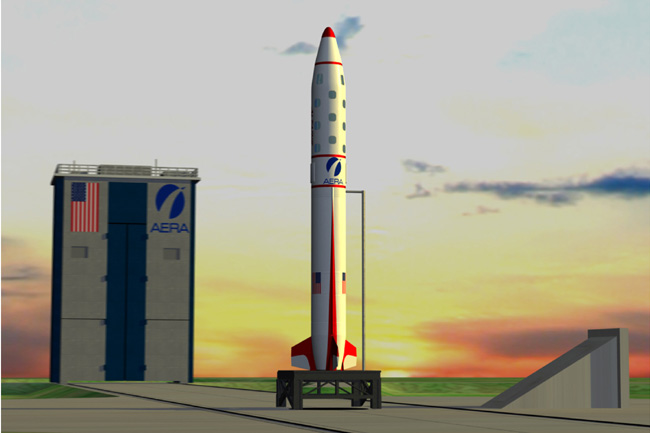Space Tourism Group Picks Florida Launch Site

A private space tourism firm withplans to launch civilians on suborbital joyrides has pinned down its launch padwith a little help from the U.S. Air Force (USAF).
The firm, Temecula,New Mexico's AERA Corp., has signed anagreement with the USAF to use launch complexes at Florida's Cape Canaveral Air Force Base forfuture passenger space shots.
"It was essential to put [it] inplace very early in our process," said Lewis Reynolds, AERA president and chiefoperating officer, of the launch site during a telephone interview. "And thefacilities there are essentially the best available the world."
AERA's agreement with USAF, renewableafter five years, allows the company access to the Air Force Station' launchfacilities and support facilities as a base for Altairis,six-passenger spacecraft currently slated to begin test flights - and possiblya commercial spaceflight - in the fall of 2006.
But even with a launch site in hand,AERA Corp. still faces major challenges ahead to make its spaceflight goals.While the company has funding from venture capitalists, plans for a spacecraftproduction facility are still being finalized. Commercial spaceflightregulation hurdles and hiring needs are also a challenge.
"We know it's a bold goal, but webelieve it to be obtainable and we are going to keep pressing forward,"Reynolds said. "Our survival and long-term goals depend on our ability to dothis safely and cost-efficiently."
Preparing for Altairis
Breaking space news, the latest updates on rocket launches, skywatching events and more!
Reynolds said the Altairis spacecraft is an evolved version of a vehicledesigned by Bill Sprague - AERA founder and CEO - while he led his AmericanAstronautics team during the Ansari X Prizecompetition.
The current design calls for avertical launch spacecraft that would then make a horizontal landing. AERAplans to unveil its Altairis design in spring 2005during an event in New York City,company officials said.
Passenger launches would includepre-flight training and a 40-minute ride, according to AERA'swebsite.
"We'll initially enter the marketwith five spacecraft, and then follow in the first year with another six," Reynolds said of AERA's current plans.
Since the spacecraft itself isdesigned to be computer-controlled, a series of unmanned spaceflights areplanned before the first passenger launch, he added.
The $10 million X Prize contest -won last year after two successful flights by the privately-developedspacecraft SpaceShipOne - challenged civilians to build and launcha reusable sub-orbital vehicle capable of carrying the mass of three people tothe edge of space and back.
A growing market
AERA's launch site announcement is thelatest in series of private space efforts aimed at providing spaceflights forpaying civilians.
However, to date only one privateeffort - SpaceShipOne designed by aerospace veteranBurt Rutan and financed by millionaire Paul Allen -has managed to not only to produce a working spaceship, but successfully flymanned sub-orbital spaceflights three separate times, two of them within twoweeks of each other to nab the X Prize.
Following last year's successful -and very public - launches of SpaceShipOne, Britishbillionaire Richard Branson pledged to license the spacecraft's technology forcommercial spaceflights at $200,000 a ride aboard VirginGalactic flights beginning in 2007.
The aerospace firm SpaceDev, of Poway, California, is also making a bid for manned spaceflightswith its DreamChaser sub-orbital spacecraft - which is part of a joint project withNASA's Ames Research Centerto study hybrid propulsion-based hypersonic testbedsfor human spaceflight. SpaceDev officials hope tomake their first test flights by 2008 if full funding is secured.
Meanwhile, the Oklahoma-based firm Rocketplane, Limited has announced its intentionsto rollout its sub-orbital spacecraft Rocketplane XPfrom Burns Flat - possibly in mid-2006 - with the first passenger flightsfollowing a year later at around $150,000 a ride. XCOR Aerospace has set thepassenger ticket price for its Xerus spacecraft atabout $98,000.
Still other homegrown commercialspaceflight efforts, including Canada'sseparate Canadian Arrow and da Vinci projects, aswell as U.S.efforts by firms like Armadillo Aerospace and Space Transport Corp. amongothers, are working to build their own human-carrying spacecraft. In 2006, XPrize officials are preparing to hold the X Prize Cupin Las Cruces, New Mexico.
A 2002 report by the market researchgroup Futron Corp. reported that by 2021, 15,000space tourists could be seeking sub-orbital flight tickets.
"Not everyone is going to pay$100,000 or $200,000 for a rocket flight," Reynolds said. "[But] there'stremendous, pent-up and unfulfilled demand out there."

Tariq is the award-winning Editor-in-Chief of Space.com and joined the team in 2001. He covers human spaceflight, as well as skywatching and entertainment. He became Space.com's Editor-in-Chief in 2019. Before joining Space.com, Tariq was a staff reporter for The Los Angeles Times covering education and city beats in La Habra, Fullerton and Huntington Beach. He's a recipient of the 2022 Harry Kolcum Award for excellence in space reporting and the 2025 Space Pioneer Award from the National Space Society. He is an Eagle Scout and Space Camp alum with journalism degrees from the USC and NYU. You can find Tariq at Space.com and as the co-host to the This Week In Space podcast on the TWiT network. To see his latest project, you can follow Tariq on Twitter @tariqjmalik.
